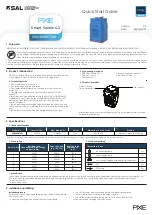
174
determines whether to initiate an RPT-to-SPT switchover process based on its
configuration.
If no receivers exist in the domain, RP 2 neither creates an (S, G) entry nor sends a join
message toward the multicast source.
In inter-domain multicasting using MSDP, once an RP gets information about a multicast source in
another PIM-SM domain, it no longer relies on RPs in other PIM-SM domains. The receivers can
override the RPs in other domains and directly join the multicast SPT rooted at the source.
Anycast RP through MSDP
PIM-SM requires only one active RP to serve each multicast group. If the active RP fails, the
multicast traffic might be interrupted. The Anycast RP mechanism enables redundancy backup
between two or more RPs by configuring multiple RPs with the same IP address for one multicast
group. A multicast source registers with the closest RP or a receiver joins the closest RP to
implement source information synchronization.
Anycast RP has the following benefits:
•
Optimal RP path
—A multicast source registers with the closest RP to build an optimal SPT. A
receiver joins the closest RP to build an optimal RPT.
•
Redundancy backup among RPs
—When an RP fails, the RP-related sources and
receiver-side DRs will register with or join their closest available RPs. This achieves
redundancy backup among RPs.
Anycast RP is implemented by using either of the following methods:
•
Anycast RP through PIM-SM
—In this method, you can configure multiple RPs for one
multicast group and add them to an Anycast RP set. For more information about Anycast RP
through PIM-SM, see "Configuring PIM."
•
Anycast RP through MSDP
—In this method, you can configure multiple RPs with the same IP
address for one multicast group and configure MSDP peering relationships between the RPs.
As shown in
, within a PIM-SM domain, a multicast source sends multicast data to
multicast group G, and the receiver joins the multicast group.
To implement Anycast RP through MSDP:
a.
Assign the same IP address (known as Anycast RP address, typically a private address) to
an interface on Router A and Router B.
−
An Anycast RP address is usually assigned to a logical interface, such as a loopback
interface.
−
Make sure the Anycast RP address is a host address (with the subnet mask
255.255.255.255).
b.
Configure the interfaces as C-RPs.
c.
Establish an MSDP peering relationship between Router A and Router B.
An MSDP peer address must be different from the Anycast RP address.
















































